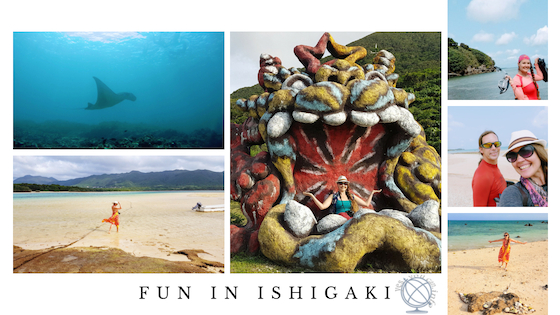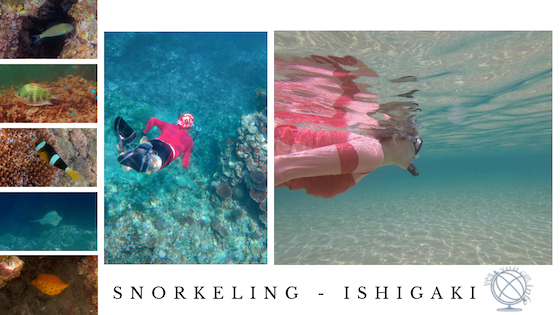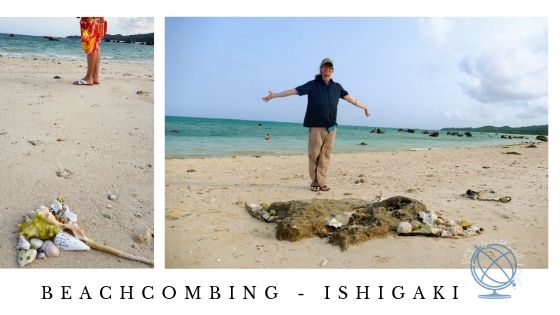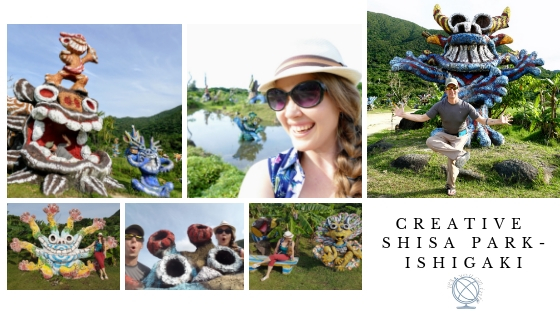This April, Josh and I took a fifty minute flight from Taipei to the little known Japanese Island of Ishigaki. We rented a car, and headed out for some exploring. It was an amazing week of diving, snorkeling, island hopping, cave exploring and beach combing. I even realized a life-long dream of diving with manta rays in the wild!
Here’s what we did, where we went and some tips in case you decide to go experience it yourself!
WHAT WE DID:
Diving
Diving in Ishigaki is a dream. There is absolutely no current and it’s renowned for crystal clear waters. Even after some days of rain during our stay, the water clarity was still between 20-30 mts. Furthermore, the waters reportedly remain warm enough for wet suit diving year round.
Of course the biggest draw for divers is the chance to see manta rays. During their mating season in September & October you are basically guaranteed to see them (read more here). But the reef mantas live in the area year round. So in the off season, if the wind is right and the boat can get you to the site, you still have a much higher likelihood of spotting them here than you do most places. We were lucky on both counts and had some incredible moments with these huge majestic creatures underwater. Our guide also informed us that April is the mating season for giant cuttlefish, which we would have LOVED to see, but you need the opposite winds for that site. So we weren’t able to go there. Well, you have to save something for next time right?!
Snorkeling
We are incredibly grateful to the Islands of Japan blog by Ippei & Janinine for their detailed directions to various snorkeling spots on Ishigaki. Some travel sites say that you can go snorkeling off most any of the beaches in Ishigaki, but the reality is just because you can doesn’t mean they are great for it. So if you’re interested in doing your own snorkeling we highly suggest checking out their blog!
Along with snorkeling gear, we brought our own wet suits but found the water was warm enough to enjoy in just bathing suits and long sleeve rash guards. The water clarity was really good considering that there had been a deluge of rain on the second day of our trip. Our snorkeling highlights were spotting a blue spotted ray and swimming with a sea snake (don’t worry, they aren’t dangerous!).
Beach Combing
Unlike some countries, many beaches in Japan seem to be OK with visitors collecting seashells (It’s hard to find concrete information on this, but unlike many other countries we don’t see any signs at the airports stating that its illegal to take shells).
If you do beachcomb, make sure there’s nothing living inside of shells! And watch for signs that give instructions about what is allowed on each beach. We do engage in collecting memories from beaches we visit. Beach glass is nice, but it pales to the beauty of shells. We also feel that if we’re going to take something beautiful off of the beach, it’s important to offset that. So we collect bags of trash at the beach and throw them away back at the hotel (Having a rental car made it possible to fill big bags, a great benefit!) We also took a moment on our last day to make some beach art celebrating the highlights of our trip – which may have to be a new beach vacay tradition for us!
Island hopping
Taketomi Island – butterflies, beaches and quaint villages: The easiest island to get to from Ishigaki is the small island community of Taketomi. The ferry takes about 10 minutes. Since we were there in the low season, the line was small, although we did have to wait for a few minutes for the next departure time. The island itself is small, and easily navigated with a rental bicycle. But we opted for the walk, and we are glad we did!
On the way to the beach, we were fascinated by all the butterflies feeding off of the roadside flowers! It took us much longer than planned to reach the beach, because we just couldn’t stop taking pictures. Strangely enough, we seemed to be the only visitors entranced by the flying jewels. Most of the tourists were headed directly for the famous star sand beach. The beach was also beautiful, but our highlight was the multiple opportunities for butterfly selfies.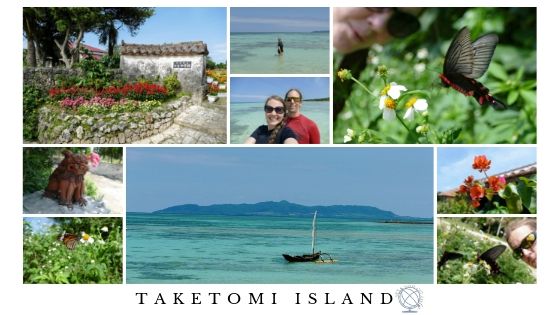
There are also other islands you can ferry to from Ishigaki, most notably Iramote We didn’t make it there but it sounds amazing – like the final frontier of Japan, wild and jungley with beautiful waterfalls and pristine beaches.
WHERE WE WENT:
Caves
There are some interesting limestone caves in Ishigaki. On a rainy day, there is no better way to get in some sightseeing by heading underground! However, the cave we visited in Ibaruma had a entrance to a “secret” beach that was really pretty. Had we known, we would have timed our visit with the low tide to really take advantage of the beach. The entrance fee was perhaps a bit on the steep side, for such a short walk. But we were one of the few visitors, and the interesting path and the strange jars collecting drips from the stalactites were worth the side trip. However, underground does not mean dry! Besides the drips from the limestone, there was also a very shallow stream running across the path at one point. Easy to walk through, but you’ll want to have appropriate footwear.
Shisa sculpture park
You might be familiar with the Shisa of Okinawa. Small stone figurines similar to the temple lions in China. They are the twin guardians of Ryukyu culture, and you find them all over in the islands of the Okinawa prefecture. We happily stumbled upon a sculpture park that featured, well, psychedelic versions of this tradition. Not an exaggeration.
There is a free sculpture park next to the turnoff for the Yonehara beach that you have to visit. We found it after missing the turnoff, and had to stop to get a closer look. There are no obvious “free entry” signs, but plenty of parking. We easily took up most of the hour getting portrait pics with the amazing sculptures. There also was a lack of “don’t touch” signs, so we weren’t afraid to get up close and personal. There was also a few shops next to it that sold smaller versions of the unforgettable statues, and we gladly grabbed a pair as a gift (and as thank you for the free park entrance)
Lighthouse sunset spot
This was one of the other gems that would have been difficult to enjoy without a rental car. As we were driving around, we decided to visit the Oganzaki Lighthouse on the west coast. It has a beautiful view of the coast, and some trails to hike to get some great pictures of the azure seas. However, the time to visit is at sunset. With almost a 300 degree view of the setting sun into the ocean, this is an amazing spot to take in the breathtaking beauty of Ishigaki.
What we learned (TRAVEL NOTES)
Getting Around
Josh and I knew we wanted to do a lot of offshore DIY snorkeling, so we decided to splurge on a rental car. We also love the freedom of getting to explore places on our own. Then again, depending on what you want to do on the island a rental car may not be necessary. All of the dive shops we talked to had a hotel pick up and drop off option – many free of charge. Taketomi Island is also a day trip easily done without a car. Busing around Ishigaki may also be an option but it sounded a little difficult because buses don’t run very frequently. Check these sites (1, 2, 3 ) if you want more information on that.
Ishigaki in April
The high season for tourism in Ishigaki is June – September when the weather is hot and dry plus there is an extraordinary Manta Scramble is happening. However Ishigaki’s water is clear and warm enough to enjoy with a wet suit year round. So Josh and I decided to check it our pre-high season, in April. Although, we made sure to avoid Japan’s golden week – a one week national holiday in Japan during which time everyone goes traveling!
Being there during the off season meant we lessened our chances of seeing mantas (but we still saw them!!), increased the chance of rain (we did have one really rainy day) and made restaurant hours less predictable. On the other hand off season also meant we got to do one dive where it was just us two, the guide and a huge manta ray all to ourselves! It also mean we had a lot of beaches almost entirely to ourselves. The rain did affect the water clarity a little, particularly for snorkeling. But it was also not scorching hot which we really appreciated and gave us more time in the water.
General Travel Tips
- Outlets: are the same voltage as in the US so no adapter needed!
- Tipping: Hotels and restaurants generally don’t expected or even accept tips -unless you’re staying at a high end Ryoken (see whototip.net for more on that)
- Shoes: some restaurants may ask you to take off your shoes before coming in. And the expectation in hotels is that you will leave your shoes right inside the door and then use the hotel provided slippers.
- Left side of the road: don’t forget that in Japan they drive on the left side of the road! This isn’t just a reminder for drivers. Pedestrians, take note! When crossing the street look for cars coming from your left!

